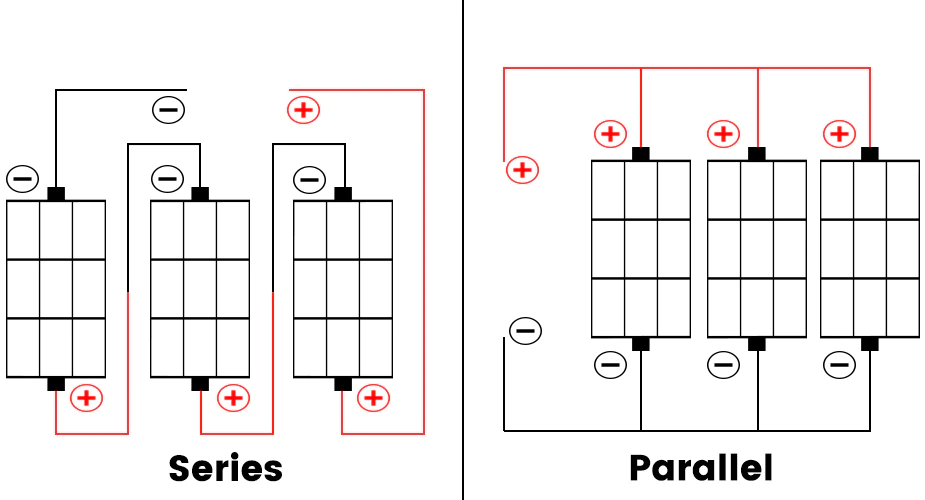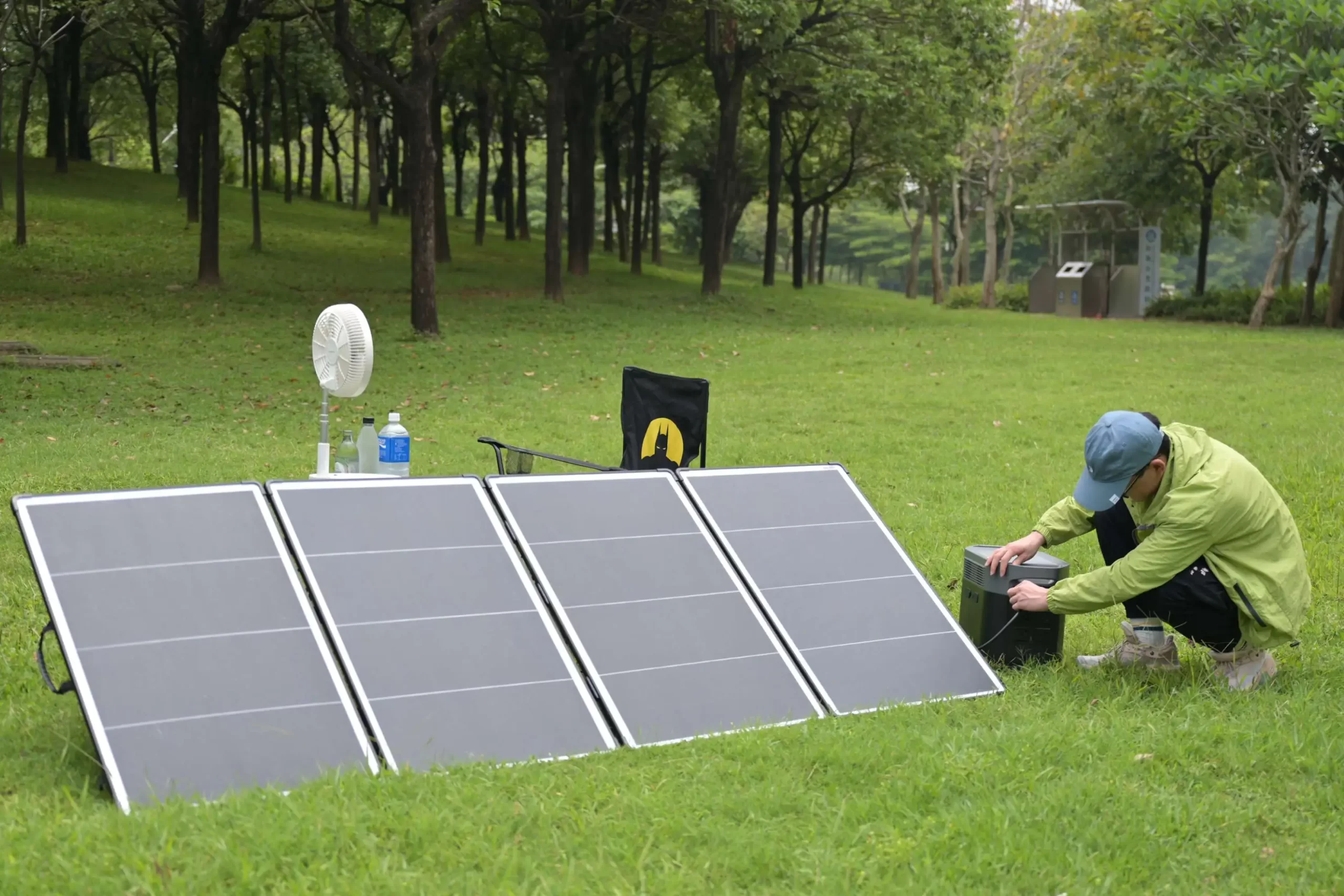There are two main ways of connecting solar panels: series and parallel. Series connection is to connect the positive and negative poles of multiple solar panels together in sequence to form a current path, with current flowing from one panel to the next.Wiring your solar panel series vs parallel— which is better? We’ll cover the pros and cons of these types of connections to help you decide which is suitable for your requirements.
Series Connection
When solar panels are connected in series, the positive terminal of one panel is connected to the negative terminal of the next panel, and so on. This creates a single pathway for the current to flow through all the panels. The voltage of the panels adds up, while the current remains the same across all panels. The total voltage of the series-connected panels is the sum of the individual panel voltages.

Advantages of series connection
Higher total voltage output, which can be beneficial for systems requiring higher voltage.
Can be useful for certain types of inverters that require higher input voltage.
Disadvantages of series connection
If one panel in the series is shaded or not performing well, it can significantly affect the output of the solar panel wiring.
The overall current output of the series-connected panels is limited by the lowest current-producing panel.
Parallel Connection:
When solar panels are connected in parallel, all the positive terminals are connected together, and all the negative terminals are connected together. This creates multiple pathways for the current to flow, and the voltage remains the same across all panels. The total current of the parallel-connected panels adds up, while the voltage remains constant.
Advantages of parallel connection
If one panel is shaded or not functioning properly, it won’t significantly impact the output of the other panels.
The overall voltage output of the parallel-connected panels is the same as the voltage of a single panel.
Disadvantages of parallel connection
Generally used when the system requires higher current output rather than higher voltage.
More complex wiring and additional components (like diodes) may be needed to manage the current flow and prevent reverse currents.
Combining solar panel series vs parallel Connections
In larger solar installations, a combination of both series and parallel connections, known as a series-parallel connection, is often used. This allows for optimizing both voltage and current levels to meet the requirements of the system.
The choice between series and parallel connections depends on factors such as the system’s voltage and current requirements, shading conditions, and the type of inverter being used. It’s important to design the solar panel configuration based on these factors to ensure optimal performance and efficiency of the overall system.
Solar panel series-parallel connection is a method of linking solar panels together to meet specific current and voltage requirements, in order to more efficiently harness solar energy and convert it into electricity.
Series Connection
In a series connection, the positive terminals of multiple solar panels are connected to the negative terminals, creating a pathway for the current. This causes the current to flow through each panel, while the voltage adds up across the panels. Series-connected solar panels can increase the total output voltage.
Parallel Connection
In a parallel connection, all the positive terminals of the solar panels are connected together, as well as all the negative terminals. This creates multiple current paths, while voltage remains constant across all panels. Parallel-connected solar panels can increase the total output current.
Series-Parallel Combination
In practical solar panel arrays, a combination of both series and parallel connections is often necessary to balance between current and voltage, in order to meet the requirements of the entire system.
Charge Controller (Charge Regulator)
A charge controller is a device that manages the battery charging process. It can control charging current and voltage to ensure proper battery charging and prevent overcharging. Charge controllers are typically designed to accommodate specific ranges of current and voltage to protect batteries and ensure the safety and efficiency of the system.
Solar panel series-parallel connection is a method of linking solar panels together to meet specific current and voltage requirements, in order to more efficiently capture and utilize solar energy. When designing a solar system, choosing the appropriate series-parallel connection method and charge controller is crucial to ensure the performance and reliability of the system.
Effectiveness Comparison:
The effectiveness of using Series vs Parallel Solar Panels connections for solar panels depends on the specific circumstances and requirements of your solar power system:
Solar panel series vs parallel: Voltage & Current
Volts, amps, ohms, and watts are terms used to describe electricity. Here’s a brief explanation of each of these terms. Voltage quantifies electrical potential energy, while amps measure electrical current and represent the rate of flow. The key point to remember is that connecting solar panels in series increases amperage while connecting them in parallel increases voltage.
To wire solar panels in series, connect the positive terminal of the first panel to the negative terminal of the second, and so on. The voltages of all panels in series are added to yield the final voltage. However, the overall current remains the same as that of a single panel.
To interconnect solar panels in parallel, first, connect all positive terminals together and then do the same with the negative terminals. The combined amperages of the panels in parallel contribute to the final current. The overall voltage, however, remains the same as the output voltage of a single panel.
solar panel series vs parallel: MC4 Connectors
MC4 connectors are commonly used in solar power systems to securely connect solar panels together. They play a crucial role in determining how panels are arranged and how they interact within a system.
Series Connection with MC4 Connectors
When connecting solar panels in series using MC4 connectors, the positive (+) terminal of one panel is connected to the negative (-) terminal of the next panel, and so on. This arrangement increases the overall voltage output while keeping the current constant. The MC4 connectors ensure a secure and weather-resistant connection between the panels, allowing for efficient power transmission along the series-connected panels.
Parallel Connection with MC4 Connectors
When connecting solar panels in parallel using MC4 connectors, all positive terminals are connected together, and all negative terminals are connected together. This setup maintains a consistent voltage across all panels while increasing the total current output. The MC4 connectors facilitate a reliable connection that supports the flow of higher current between the parallel-connected panels.
It’s worth noting that MC4 connectors are designed to be easy to use, durable, and resistant to environmental factors like water and UV radiation. They have become an industry standard for series vs Parallel Solar Panels connections due to their efficiency and reliability.
In summary, there’s no one-size-fits-all answer to whether series or parallel connections are more effective for solar panels. The choice depends on factors like the system’s voltage requirements, shading conditions, maintenance considerations, and more. In some cases, a combination of both series vs Parallel Solar Panels connections might be used, known as a series-parallel configuration, to balance voltage and current needs while minimizing the impact of shading.
solar panel series vs parallel FAQs
Can you combine solar panel series vs parallel?
Yes, in some cases, a series-parallel combination of solar panels is used, especially for large solar arrays. On the contrary, this type of connection is uncommon for small residential loads.
Which is better: solar panel series vs parallel?
When deciding what type of configuration is best, the ultimate question that you should answer is if a series or a parallel connection will provide you with the optimal energy to meet your requirements.
You can choose to connect your solar panels in series if you need a low-amp solar system and if your panels remain under the sun for most of the day. On the other hand, if you want a low-voltage system or if you live in an area with mixed-light conditions (then you want to have your solar panels operate independently) connecting in parallel is the better option.
What is the difference between connecting solar panel series vs parallel?
Series Connection: In series, the positive terminal of one solar panel is connected to the negative terminal of the next. This increases the total voltage of the system.
Parallel Connection: In parallel, the positive terminals are connected together, and the negative terminals are connected together. This increases the total current capacity.
Which configuration is better for increasing voltage?
Series Connection: Connecting panels in series increases the voltage. This is beneficial when you need higher voltage for specific applications or if your solar inverter requires a certain voltage range.
Parallel Connection: Parallel connections do not increase voltage but rather increase the current. This is useful when you need to maximize the current output of your solar panel system.
Which configuration is better for increasing current?
Series Connection: Series connections do not increase current; they increase voltage. If your goal is to maximize current, parallel connections are more suitable.
Parallel Connection: Connecting panels in parallel increases the total current. This is useful when you want to maximize the power output of your solar panel system.
How do series and parallel connections affect shading issues?
Series Connection: Shading one panel in a series can significantly reduce the overall system output because the current passing through all panels is limited by the shaded panel.
Parallel Connection: Shading one panel in a parallel configuration has a lesser impact on the overall system output. The output is affected only for the shaded panel, and the others continue to operate independently.
What are the considerations for the type of inverter used with series or parallel connections?
Series Connection: Series connections require inverters that can handle higher voltages. String inverters are commonly used for series-connected panels.
Parallel Connection: Parallel connections require inverters that can handle higher currents. Microinverters or power optimizers paired with a central inverter are often used for parallel configurations.
Can I combine series and parallel connections in the same solar panel system?
Yes, hybrid configurations are possible. They are known as series-parallel configurations and involve a combination of both series and parallel connections to achieve a balance between voltage and current.
Remember that the optimal configuration depends on your specific energy needs, shading conditions, and the requirements of your solar power system. It’s recommended to consult with a solar professional for a customized solution.













